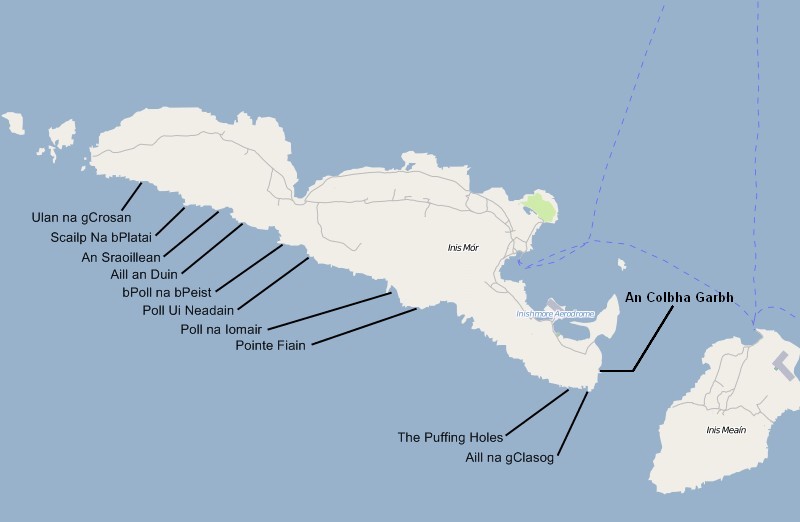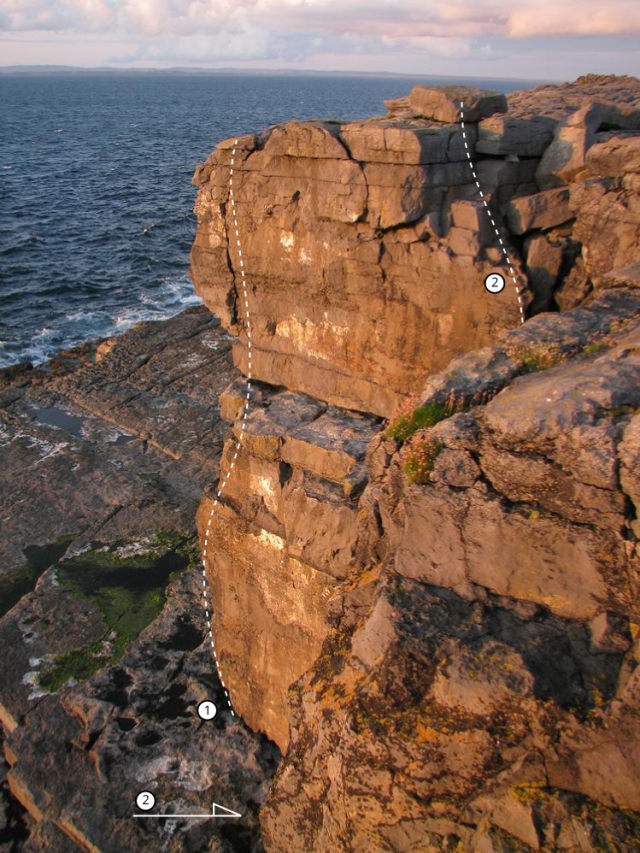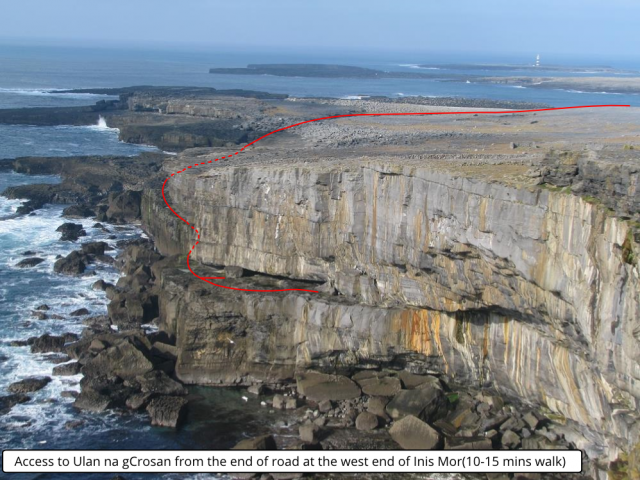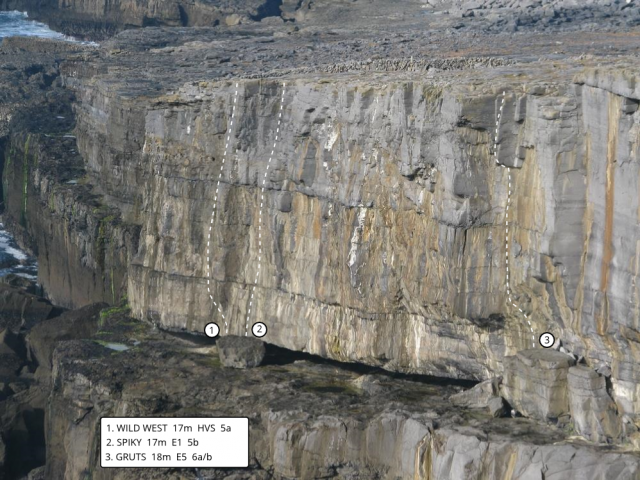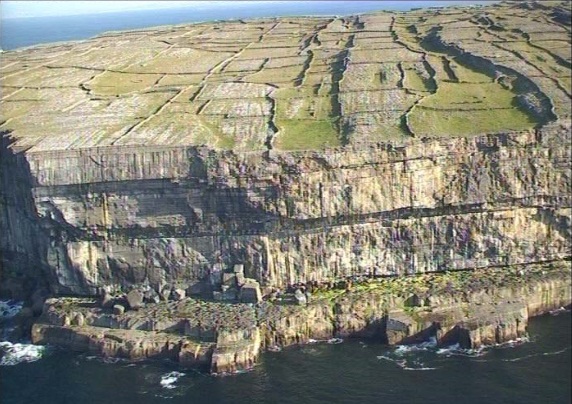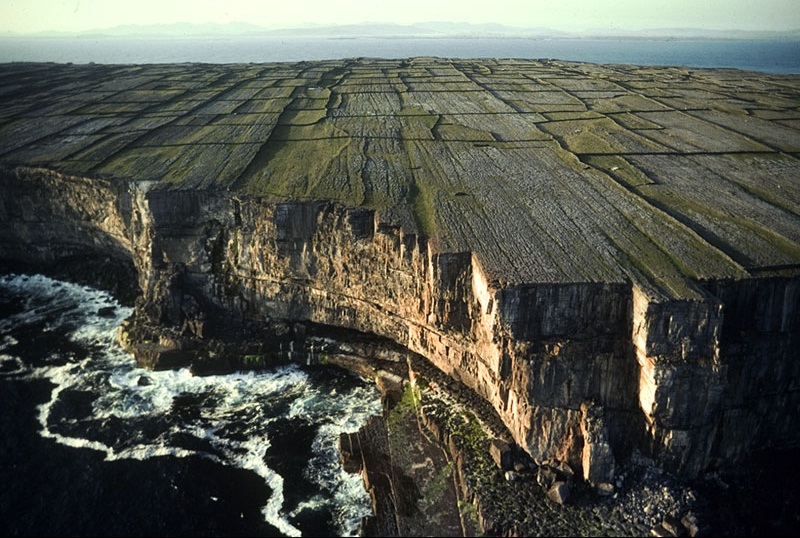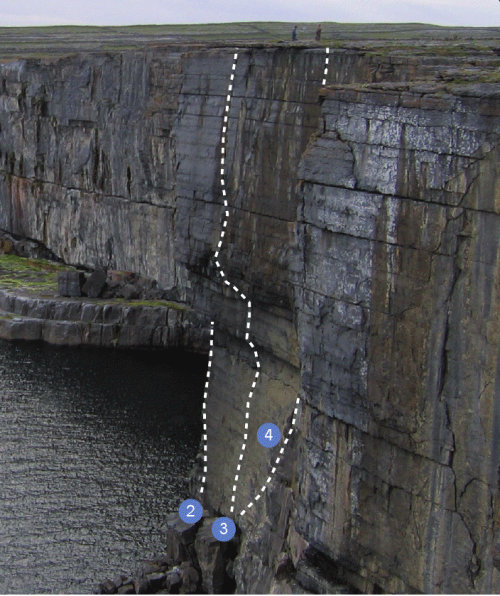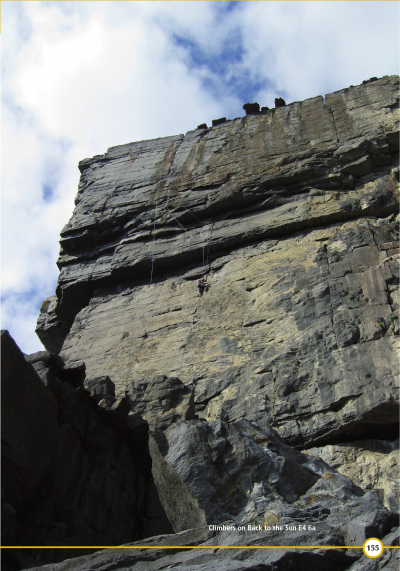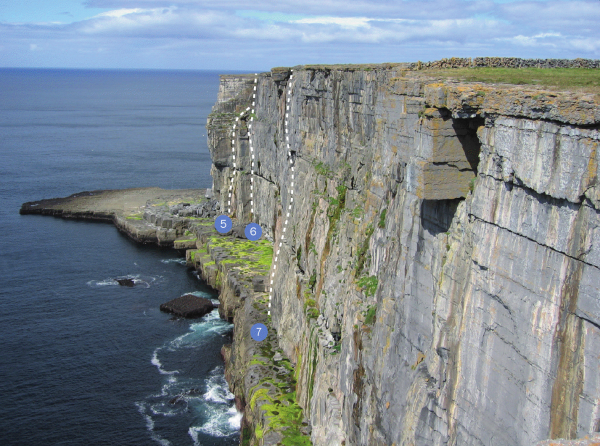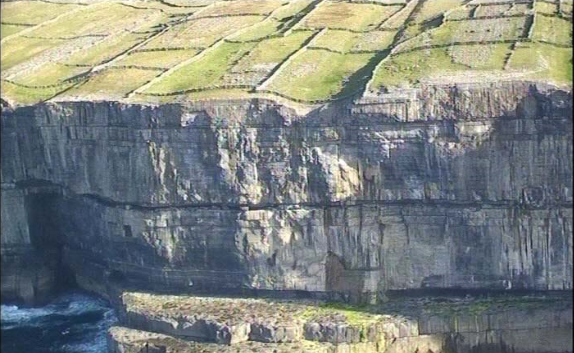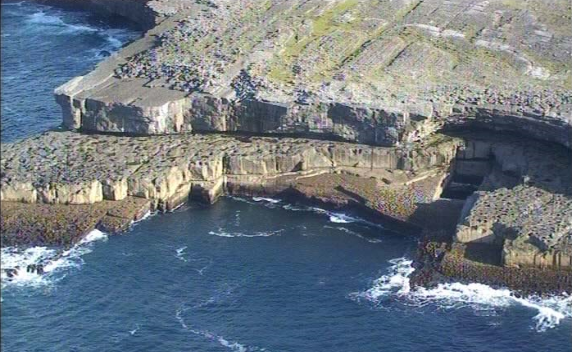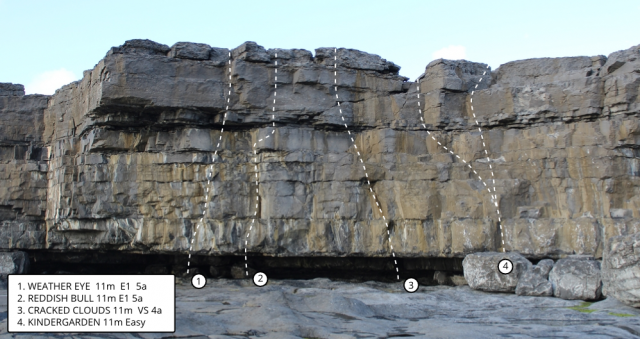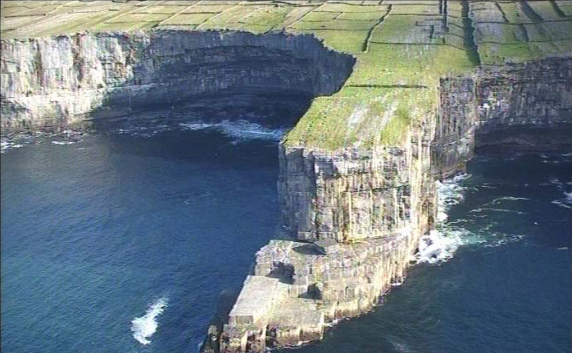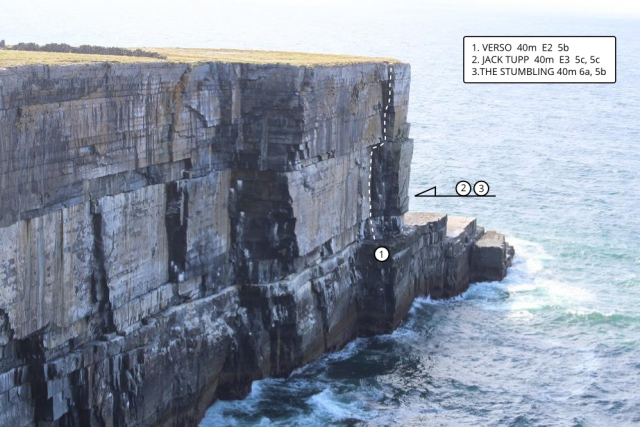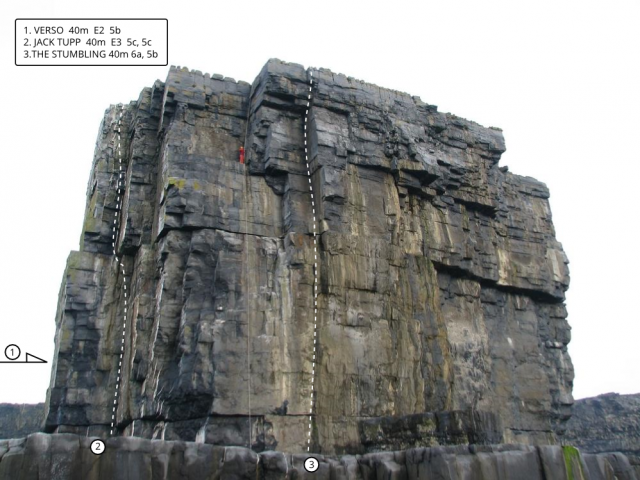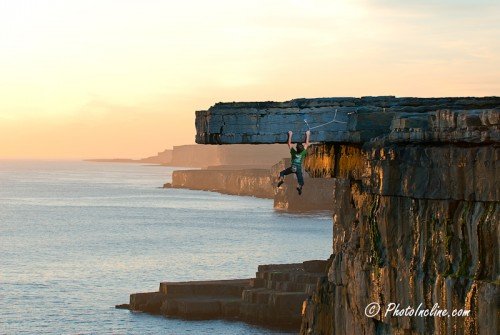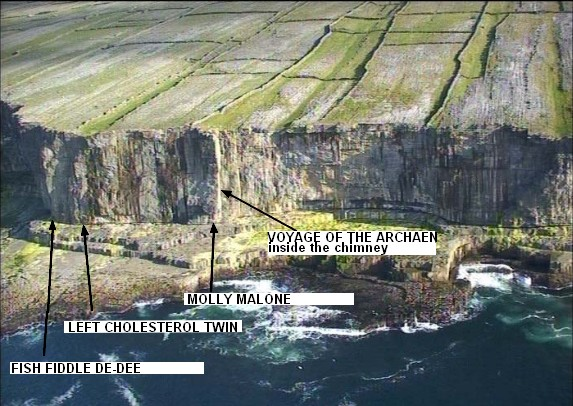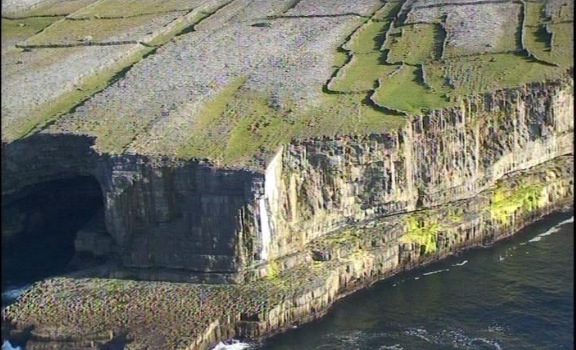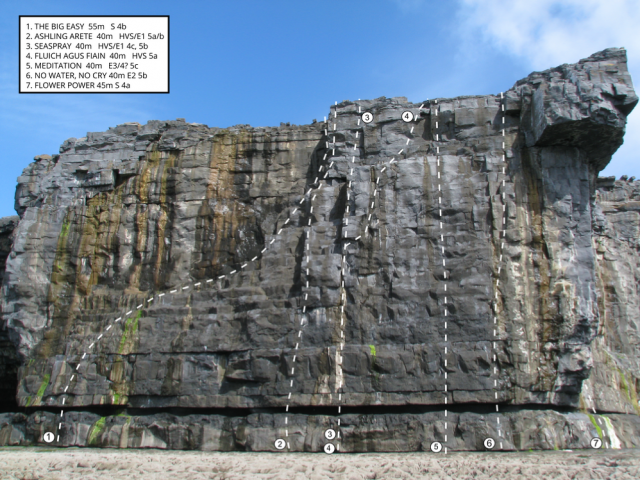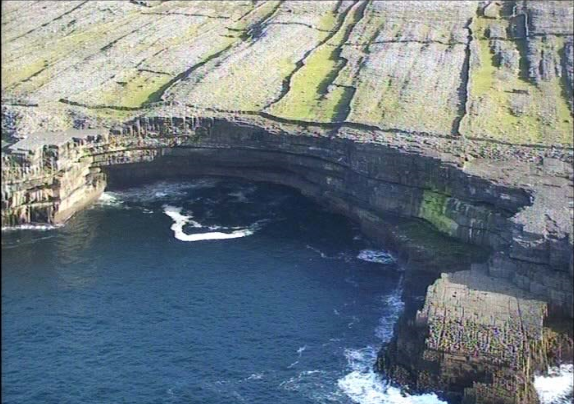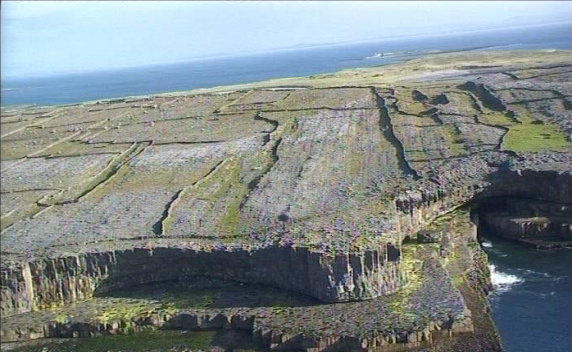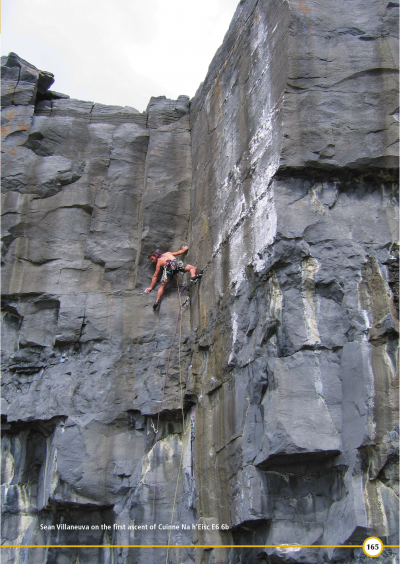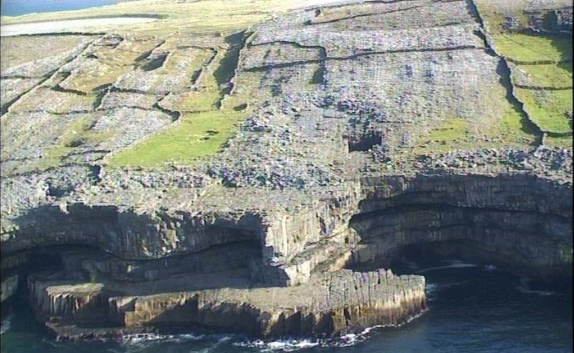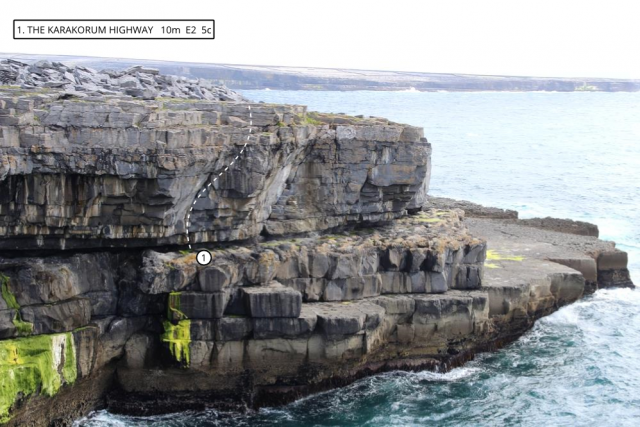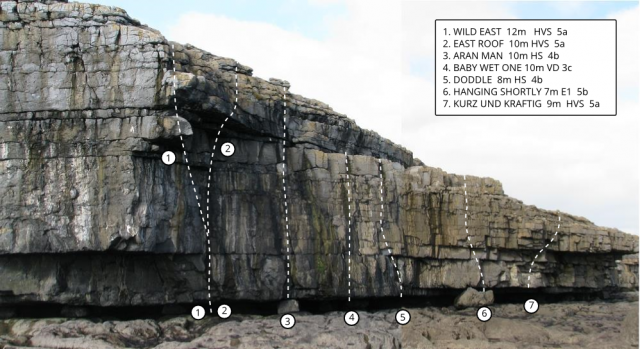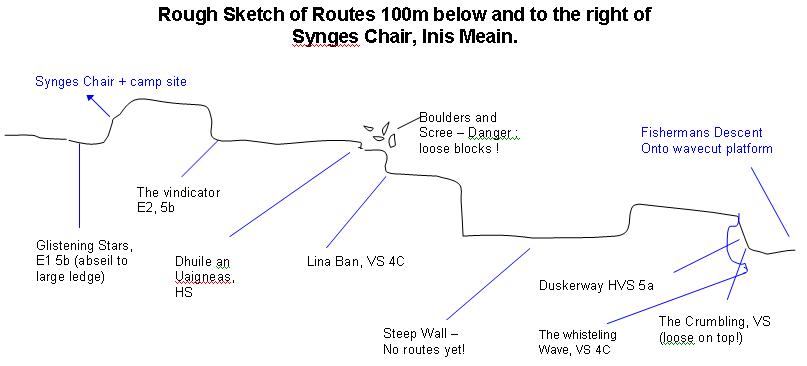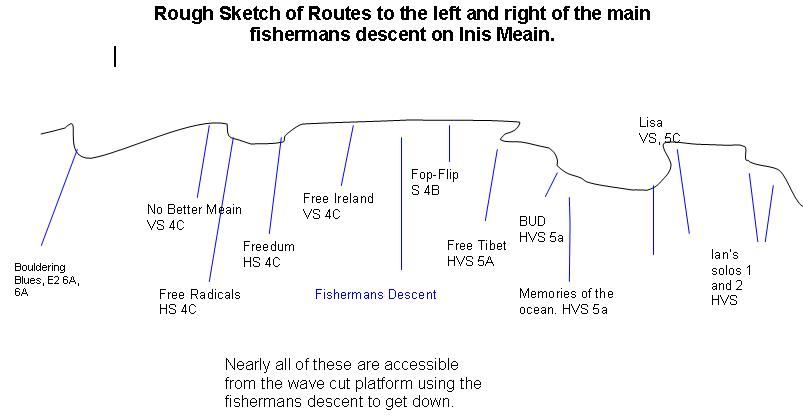Aran Islands
Tim Robinson has written a magic book about Aran called "Stones of Aran: Pilgrimage" in which he makes his way around the coast with descriptions of the cliffs and their history before we climbers appeared on the scene.
It is a must-read for anyone who climbs there.
His book about the interior is "Stones of Aran: Labyrinth"
Inishmore
“The Gaelic speaking Aran islands are famous for their unique way of life, where age old traditions co-exist comfortably with modern living. Inis Mór the largest of the three islands is an ancient land, set in an endless sea where great labyrinths of limestone sweep upwards to the breathtaking cliffs with their panoramic views of Connemara and County Clare. See the striking limestone landscapes of Inis Mór. A myriad of stone walls, small fields and a maze of bóithríns (small roads) will lead you to all corner of this majestic island.”
…….. or so goes the tourist leaflet in its aim to ensnare the culture vultures on their mission to find the “real” Ireland.
Árainn (also known as Inishmore), the largest of the three Aran islands is situated 14kms off the Galway coast and can easily be reached by a variety of ferry operators sailing from both Galway and Clare. Alternatively, there is also a small airport on the island for those of you wanting to travel in style. Once on the island the most efficient form of transport is cycling and with no less than 3 rent-a-bike shops located just off the pier you are spoiled for choice. The average cost is around ten Euros per day but this can vary greatly in your favour depending on how business is going that day and how chatty you are! Accommodation is available to suit all budgets with b&bs and hostels dotted all over the island as well as a tiny campsite located centrally in the low lying east of the island. As the island relies heavily on tourism wild camping should be avoided in favour of the campsite, and for a mere 4 Euros per night you get the added bonus of toilets and running water. Finding your way around the island is made much easier with the aid of Tim Robinson’s excellent map, available at the tourist office on the island. This meticulously drawn labour-of-love, names every cove and inlet on the island and is essential for locating key climbing areas (and potential new ones!)You can also find a free => Aran Island Travel Brochureproduced by Glenaran Irish Sweater Market and it is available for free download.
And now, the climbing………
The island is in essence one huge limestone crag, with almost 20kms of coastline offering a wide variety of climbing styles covering all grades. The Northeast side of the island is quite low lying but does contain a number of extremely high quality crags up to 10m high nestled in between the numerous beaches and coves. The nature of these outcrops ideally suits them to bouldering, with good level landings, a predominantly overhanging style of climbing and solid top-outs.
At the other end of the spectrum is the Southwest length of the isle, which rises to heights of over 80m in sheer cliff faces and runs continuously from north to south. Until recently the majority of the climbing development on the island was undertaken by visitors from England and Wales due to the intimidating nature of the crags, with only very few routes being established by Irish climbers. 35 or so of these early, pioneering routes were included in the Burren Guidebook published in 1997 by the MCI. The grades of these routes centres mainly around the mid “E” grades with an upper limit at present of E6. These grades were not however a true reflection of the range of climbing on the island, rather more a display of the strength and ability of the climbers who took the time to pursue these new and quite bold lines rather than the more obvious and attainable lower-grade climbs. Since those early explorations of the island, development has been slow and sporadic with handfuls of lines being done in different areas, giving dense pockets of routes dispersed along the coastline. The tendency seems to be to find a previously unclimbed area that suits a personal climbing style and blitz it of it’s obvious classic lines and then move on.
The climbing itself ranges from long exposed multi pitch lines to short, sharp single pitch routes all on good limestone. Stepped Overhangs and impressive sheer walls abound, with most of the established routes taking devious lines of weakness through this improbable terrain. Protection is solid where found, although quite often sparse due to the compacted nature of the limestone. All current routes have been climbed in the traditional Adventure climbing style and only very few routes contain pegs (sometimes placed on lead and by this stage untrustworthy). Another feature of the island is a number of huge and seriously overhanging amphitheatres, which at first seem reminiscent of Muckros head, Donegal until you notice the lack of natural protection available. These will absorb a lot of time and effort (and maybe even bolts!) before they start to release lines, all of which look spectacular and at or above the upper limit of the climbing currently established in Ireland to date (but possible none the less…. What can I say, I’m an optimist!).
Since the recent popularity and speedy development of Gola Island in Donegal, more and more people have been looking towards the Western Islands as a potential hotspot for new routes. With over 20 new routes established all over Árainn already this year from severe to E3/4, hopefully this trend will continue to grow and reveal what has the potential to be one of the best and most impressive crags in Ireland.
Access - Inishmore is well served by ferries and by a local air company, details from the Tourist Office, Eyre Square, Galway. Telephone (091) 68903, Fax (091) 68538. The island is not a practical venue for a weekend unless the air service is used. The cliffs are exposed to the full ferocity of the Atlantic gales and even in summer climbers should be open to the cultural possibilities of the island as they may have a lot of time on their hands.
Maps - Tim Robinson's meticulously drawn map of Oileáin Arainn is invaluable for locating routes on Inis Mór. It is a labour of love which pays homage to the riches of the island and in practical terms it is essential as route descriptions in this guide refer to the original Irish place names on this map which are often not used on standard maps.
Accomodation - The islanders cope with a huge influx of tourists between May and September each year and there are numerous guesthouses and hostels. There is a campsite in operation in summer months and camping wild (and tidily) is also possible but water may be hard to come by.
Climbs and grades - All route descriptions and grades are provisional as none of these climbs has been repeated.
Red text indicates that a route more than likely no longer exists.
Green text are prompts that won't appear in the next guide.
If you would like a list of all the routes established on the island this summer, or even just want some extra information or suggestions on good climbing areas on the island, I can be reached at : daveayton@hotmail.com.
Happy climbing!
Dave
Leic na gCleireach
This area is located at the North-West end of the Inis Mor. Access to the non-tidal platform below the wall is possible by abseil or descent at the NE end of the wall (about 500m from where the routs are). Description is from NE (left) to SW (right).
LIGHT IN A SHADOW 23m E2 5a
This route is located on the prominent arête about 50 m to the left from first (from NE) big boulder on the non-tidal platform. Climb the arête to the big ledge (no-hand-rest), from here climb straight up a crack to the top.
NORTH SIDE CORNER 23m S 4a
In the corner about 50 m to the left from first (from NE) big boulder on the non-tidal platform, 5 m to the right from LIGHT IN A SHADOW. Climb the corner to the big ledge, from here climb left side of the corner to the top. Some loos rocks in the corner.
Ulan Na gCrosan
The cliff rises from a sea-level ledge system and the obvious features are two grey square-cut corners with overhanging starts at the right-hand end of the ledge. There is one recorded route on a small cliff in this area at the western corner of the island.
Two routes start at a boulder that is located about 50 m to the left from the east end of the ledge.
WILD WEST 19m HVS 5a
From the boulder travers left over the arête and climb the face on the left side of arte to the top.
SPIKY 18m E1 5b
On the face to the right from the corner are 3 vertical cracks, the route take the line through the middle one. Some sharp rock.
Next route start at a boulders at the east end of the ledge.
GRUTS 18m E5 6a/b
C. Waddy, 26/9/86. This was an on sight ascent using unspecified aid.
Start at a pile of boulders 3m right of the left-hand corner. Move up and left into the corner using loose jugs. Climb the corner with increasing difficulty until it splits into three at a small roof. Using underclings move strenuously through a loose section to below a left-hand slim groove which is followed to the top.
Binn an tSleibhe Mhoir
Approximately 0.5 km west of Scailp Na bPlatai. A 300m length of cliff with ledge beneath it. Nothing recorded here?
Scailp Na bPlatai
Approximately 2.5 km west of Dún Aengus an L-shaped terrace (Leic an Clochair Bhig) juts out to sea. A little north of this a 25m high boulder pile (An Clochair) forms a pedestal below an impressive square-cut buttress. This buttress forms one side of the huge cleft of Scailp na bPlátaí. Care should be taken as there are deep clefts and chimneys in the area. The terrace can be reached by abseil, giving access to the routes on the buttress above or by scrambling down the Clochair.
Alternatively you may wish to try the traditional fisherman's access route down Scailp na bPlátaí , along Ulán na mBos and Ulán na Téide and scrambling down An Clochar. Sea level ledges give access to the huge cliffs around to the east. The first two routes start down and left of a large fallen block.
EQUINOX 46m S
C. Waddy (solo), 22/9/86.
An escape route but worthwhile. Start beneath the big corner/chimney system down and left of An Clochair.
(1) 33m Climb up the slabby left wall of the corner, keeping close into the corner itself, to the ledges.
(2) 13m Climb blocks into the chimney on the right and enter this, taking the easiest line to emerge at the top.
DOPPLEGANGER *** 49m E2/3 5c,5b
C. Waddy, T. Kelcey, 25/9/86.
A good exposed route but escapable between pitches. Crawl 7m left to the end of the roof-capped ledge. Belay.
(1) 38m Climb straight up to a break beneath the main roof (crux - serious). Traverse left into the main corner line where the overhangs end (possible belay). Climb the corner until 3m below the capping roof. Traverse left to the arete and move up to a ledge below the short continuation corner which leads to a spacious ledge. Care must be taken to avoid rope drag.
(2) 11m Starting 3m right of the arete, climb straight up to a break which is followed left under a small overhang to the arete. Pull over this and climb to the top.
The next three routes start off An Clochair.
FACE TO THE WIND ** 49m E2 5b,5c,5c
C. Waddy, T. Kelcey, 27/9/86.
A very exposed and interesting climb up the left arete of the wall. High in its grade. Start from the pedestal 4m left of the obvious thin crack taken by Back To The Sun.
(1) 18m Climb directly up the wall (a number 2 RP is the first protection at 8m). Trend left into a break which leads horizontally left to join the arete above a bulge. Climb the left-hand side of the arete to a ledge.
(2) 9m Pull through the roof above via a crack and stand up in the break. Traverse left and then step up to a wide break 1m higher. Continue left around the arete and swing up to an exposed belay in the hanging groove.
(3) 22m Gain a sloping ledge on the right, then continue up the groove in the arete. Undercling up a smooth section (crux) and awkwardly gain a ledge on the right. Alternatively this can be avoided via a loose block on the right. Continue more easily up cracks to the top.
BACK TO THE SUN *** 42m E4 6a,5b
C. Waddy, T. Kelcey, 24/9/86.
Climbed in one pitch by Kevin Power in 2006 at E4 6a.
A fantastic route taking the striking central line, giving sustained and varied climbing. High in the grade though very well protected. Start from An Clochair.
(1) 30m Climb the wall to the right of the crack initially, then follow the crack to the first roof. Go over this and then traverse 5m left to a crack through the next roof. Pull over this and then swing up left into the continuation of the crack above. Climb this to a thin ledge above. Strenuous.
(2) 12m Ascend the crack above.
THE FISTYMAN 49m E3 6a, 5b
C. Waddy, T. Kelcey, 25/9/86.
The right-hand line through the roofs and the wide crack above.
(1) 37m Traverse right for 10m from the pedestal to the easy crack which leads to a ledge below the roof. Step right and follow the crack through the roof, then trend left into a short steep hanging groove. The block at the top of the groove is detached but seems safe.
(2) 12m Jam the widening crack to the top.
Scrambling to the bottom of An Clochair leads to a curving ledge system under monstrously overhanging rock which opens out to the protruding ledges at Leic an Clochair Bhig. Continuing eastward along the spacious ledges the cliff forms a long continuous wall 200m long and 80m high. 60m right of the corner system at the left end of the wall is a solitary square-topped boulder abutting the cliff. 25m right of this is an area of pink rock with a prominent overhang at 5m. Directly above the pink rock a series of stepped overhangs breaks the skyline. To the right of the pink rock there is an area of grey/green brittle rock. Just to the right of the boundary between pink and grey/green a short flake leads leftwards to a small ledge at 5m.
TOM AGUS MICK *** E4 6a, 6a, 4b
The route starts up the rightmost crack on the front
wall of the pillar.
(1)Bouldery moves on rough rock
lead to the start of the crack. Climb the crack to just
above the blocky section before stepping left into
the next crack system. Finish up this to the spacious
ledge above.
(2)The second pitch is brilliant. Step left from the belay
to the bottom of the crack system. Climb this with
sustained difficulty to the large ledge at the top of
the pillar. The climbing is varied and well protected.
THE FLYING SQUIB E2 5c, 5b
Adventurous climbing up the crack which splits
the east side of the pillar. The rock is hollow and
crumbly.
RIDE THE SNAKE 88m E2/3(4b,5c,5c)
T Foord-Kelcey (led pitch 1 and 2), C Waddy (led pitch 3) 27/9/1986
A tortuous and disturbing expedition into the heart of the wall. Start 3m right of the bottom of the flake.
(1) 30m Pull onto the slab wall and move up leftwards to small ledges and a break line at 8m. Trend up and slightly right for 7m, then left onto the prominent rightwards-trending ramp. Follow the ramp to its end at another breakline. Move right for 3m then up to another break. Right again then up to the terrace. Practically unprotected. Walk 10m left and belay on second last long boulder.
(2) 33m The prominent feature on the wall above is a rightward-trending flake that blanks out after about 10m. Stand on a helpful boulder and layback up onto the lip of the roof, below where the flake begins. Traverse left on the obvious line to a small ledge. Climb optimistically up the poorly protected featureless wall above with a short detour diagonally right then back left again. Continue to finally reach better protection and a hard move to gain the horizontal breakline. Step up left to a ledge, then traverse back right for 8m along the break and belay beneath a flake crackline above.
(3) 25m Follow the obvious flake crack to the top.
Continuing further along the ledges to the right, not far before they stop, is an obvious projecting buttress with an overhanging middle section. This contains the following route.
HOTEL BASTARDO * E3 5b,5c,-
C. Waddy , J. Biddle, 1990.
(1) Climb the obvious groove in the middle of the wall above.
(2) Continue up the overhanging crack.
(3) Finish easily to the top.
An Sraoillean
This area is best reached by continuing north west along the cliff-top from Dún Aengus until the large crescent-shaped bay of An Sraoilleán is reached. Most of the walls in this area are seriously overhanging but on the western side of the bay there is an obvious white pillar with a good ledge on its seaward face. Just before this is a slabby grey wall bounding the bay.
GUINNESS CONVERT - THE WALTZING BEER MONSTER VS 4c
P. Cobb, B. Molyneaux, 15/7/92.
A pleasant and surprisingly amenable route which climbs the obvious crack in the left-hand side of the grey slab, close to the arete. It is reached by abseil to a ledge at the foot of the slab - be careful not to go over the overhanging rock below. Move up onto the slab and follow the crack on extremely sharp rock to a flake leading to a break just below the top. Finish direct.
VIRGIN ATLANTIC E2 5b
G. Whittaker, R. Spillet, 15/7/92.
This route takes the centre face of the white pillar. Reached by abseil (bring a second rope as the anchors are well back from the edge) to a ledge above the steep and often wet lower section. Quite bold but never desperate with good moves all the way. Start next to a large block several feet left of an obvious shallow groove running up the centre of the face. Pull onto the wall and gain a good horizontal break. Traverse right to the base of the groove. Follow the groove and gain a good break below the tiered overlaps. Make a hard move up to the next break and continue up until a delicate move leads right to a ledge. Finish boldly up the centre of the final wall or up a vague groove to the right.
Aill an Duin
The ledges here start about 300m west of the Dún and continue a little to the east of it. Abseil to the ledges at the west end and as you walk rightwards you will see two major cracklines. The first has a very wet bottom; the second, approximately 300m further on, has a very steep start. This latter is Unnamed and finishes just left of the left wall of the Dún
UNNAMED *** 65m E5 6a/b,6a/b,6a
C. Waddy , J. Biddle, 1990.
(1) 25m Start up the crack (crux) and continue, easily at first and then at about E3, to a fault.
(2) 25m Step up and right, then up a quartzy-walled groove until a swing left along breaks leads to a belay.
(3) 15m Up to the roof, left around it then up a short exposed groove to the top. The line finishes just left of the western outer wall of the Dún.
There is a depression in the cliff top inside the western outer wall of Dún Aengus. This route climbs the wall below via a groove-line. A 30m free abseil leads to an obvious ledge two-thirds way down the cliff. A good push off the capping stone is needed to swing in to the ledge.
THE RHYTHMS OF THE SEA 35m E4 5c
B. Molyneaux, P. Cobb, G. Whittaker, R. Spillet, 14/7/92.
The route follows the big leaning brown groove to the right of the steep grey of the abseil line. Start up the calcite crack/seam up past several overlaps and ledges to reach a good ledge. Above the groove steepens and blanks out. Move left and up into a smaller groove which is followed to a good break (crux). Swing back right to regain the main groove which is followed to the top, moving slightly right to avoid an unstable finish. Protection generally good throughout.
Poll Na bPéist
Wall south east from Dún Aengus past the large undercut, crescent-shaped bay of An Sunda Caoch to overlook the pool of Poll na bPéist on the terrace below the cliff. It can be reached by walking further south east and scrambling down to the non-tidal ledge or by abseil. The surrounding walls provide numerous short routes or excellent bouldering, especially in the amphitheatre above the Poll. Some lines (up to 5a) were climbed here by G. Whittaker in 1992 and by J. Hawkins in 1994.
MIDGE 6m D 3a
J Hawkins, T Fritzsche, 21/9/1994.
Climb corner to the top.
WORMS IN THE KITCHEN VS 4c
J Hawkins, T Fritzsche, 21/9/1994.
Climb corner to the top.
YET ANOTHER INSECT HVS 4c
J Hawkins, T Fritzsche, 21/9/1994.
Climb shallow corner and arete to the top.
All routes are described from left to right beginning at the north end of the non-tidal platform, past the Poll, from where you can see Dún Aengus.
The following two routes are located on the cliffs north of the Poll.
Michelle 15m Severe
M. Grey, J. Hession 2001
Climbs the obvious right facing corner and ledges at the far end of the non-tidal platform
Gravity's Rainbow 13m Vs 4c
I. Mulvany, C. Burns 02/05/02 Onsight Solos
To the right of Michelle is a face which cuts inward in a series of ledges.
Standing by the first hanging ledge reach up for the obvious good hold. Haul your candy ass up onto the first ledge and mantelshelf to the top.
The next routes are located to the east of the Poll.
It's Easier If You're Tall, Denis E1 5b
A. Dineen & A. Ní Cheallaigh-Mhuirí 31-Aug-2020.
On the east side of the Poll, between the fallen corner of Thug Time and the east side of the roof. Fell at on-sight attempt, completed climb and led clean the following day.
High reach or jump for the corner of the ledge at 8ft (Second aided reachy move), balancy move to get established on ledge (Felt harder than 5b for the onsight, but with the beta, probably 5b). Small gear in top of hairline crack to the left. Take the line of least resistance as you move through horizontal breaks and step right on to bigger ledge. Easily top out.
THUG TIME 13m HVS 6a
G. Whittaker (solo), 14/7/92.
Check out the grade. The route climbs the undercut right-hand arete of Pool Wall by making a very strenuous move up on sidepulls to gain the horizontal break above. Swing left then, using underclings in the break, move up to a good hold on the arete. Finish easily.
WELL HUNG 13m HS 5a
Start 3m right of Thug Time below a thin vertical
crack, which splits a ledge at 2.5m. A hard boulder
start gains the ledge. Finish easily to the top. Height
is an advantage.
TIME TO SWIM 10m HS 4c
4m right from undercut arête (the place where was THUG TIME) just south-west of the poll, the route start at the right hand end of the roof and below left hand end of small ledge at 3m height. A very strenuous move to the ledge on the right, finish easily with very good protection.
Zoltan 13m E2 5c
This takes the clean undercut wall with two
horizontal breaks which is capped by a friable
looking overhang located around 50m right of Well
Hung.
Start 4m to the right of the sharp vertical crack. Pull
strenuously on crimps to reach the first horizontal
break and become established on small edges for
feet, from here move directly up to the next break
(medium wires and small friend). Trend slightly
left and then cautiously back rightwards to finish
through the overhang.
Repulsion 13m E1 5b
Start in the corner immediately to the right of Zoltan.
An awkward start sees one standing the corner (good
wires above). Reach out to the arête and swing out
left and compose yourself on the horizontal breaks
while placing gear (tricky). Continue to the top then
marvel at your seconds hatred for the route.
Hands Solo 14m E2 5c
Climbs the direct line up the undercut clean vertical
wall located in a recessed area in the middle of the
crag. A short campus board session and a heel-hook
sees you established on the wall. From here climb
on, trending slightly leftwards, along an obvious line
of weakness using flat edges.
Nuala's cousin 14m HS
Start as for Nuala, with your feet on the boulder move into the left corner then straight up.
Nuala 14m S 4c
Start at an undercut wall supported by a slightly
protruding chest height bolder. Scramble onto the
boulder and then climb up and then vaguely left
through the crack system.
Ciarán 14m S 4c
As for Nuala but climb rightwards to shallow corner
from the top of the boulder.
Mc Chuzwozla 13m HVS 5a
Takes a direct line up the steep wall 8m to the left of
Dolphin. Start 3 m left of the arête. A strenuous start
get one established on the wall then climb direct
to top following the vague groove trending slightly
leftwards.
Raped By Fairies 13m E1 5b
Climbs the overhanging wall to the right of Mc
Chuzwozla. Start just left of the arête. Involves
trusting some all-to-breakable crimps en-route to a
less steep finish.
Dolphin 13m VS 5a
This takes the right end of the undercut slab 80m
left of the descent. A dynamic start gains the first
shelf. Mantel on this and continue using good flat
holds to the top.
All The Way Bitch! 13m E1/2 6a (after 2013/14 winter storms is easier - E1 5b)
Starts at the back of the recess to the right of
Dolphin. Climb the short corner to the roof. Reach
around this to the juggy break and then on to the lip
of the roof. A long move up and right to a crimp and
a high left heelhook sees you past the crux. Finish
easily.
Aran Chowder 14m VS 4c
Climbs the corner 3m to the left of JoJo-A-GoGo.
Some loose rock.
JoJo-a-GoGo 14m HVS 5b
This takes a direct line up the slightly overhanging
wall 40m left of the descent. Distinguished by it’s
non-undercut base. Begin at a small jammed block
at chest height. Climb directly up to gain the first
ledge. From here move cautiously up to gain next
ledge with the aid of a shallow corner. Finish easily.
Silk Bogroll 13m VS 4c
Climbs the right hand end of the clean, undercut
wall 8m to the right of JoJo-A-GoGo. Very enjoyable
climbing on solid rock. Crux at start.
Blowhole 10m S 4c
This climbs the v-groove with a quartz seam just
right of Silk Bogroll. A testing start gains the groove.
Some loose rock towards finish.
Leic an Niochain and Poll Ui Neadain
These cliffs are near the village of Gort na gCapall. The first routes lies on a small cliff near the place where the track from Gort na gCapall meet the coast in the bay to the east of Poll na bPéist. Walk south east along the platform beneath the cliffs for about 100m, the routes are located on 11m high undercut cliff to the right from huge roof.
WEATHER EYE 11m E1 5a
In the middle of this face is a corner, start 4 meters left from the corner, climb diagonally right to meet the corner just under an overhang. Climb the overhang straight up to the top.
REDDISH BULL 11m E1 5a
Climb the corner up to the overhang, from here travers left over an arête and finish straight up on the left side of arête.
CRACKED CLOUDS 13m VS 4a
Start 5 meters from the corner, climb rightward to the ledge in the middle of the high, from the left side of the ledge climb straight up.
KINDERGARDEN 12m Easy
At the right end of the face are series of ledges and corners. Few options to climb there. Good fun for kids or could be used as a descent.
Next routes are located at the end of the non-tidal platform where a collection of huge boulders below the cliffs with prominent arête is.
DEEP BLUE HVS 12m 5a
Climb the prominent arête, this route start from one of the huge boulders below the cliff.
LEFT CREVASSE 12m VS 4a
2 m to the right from arête is a big crevasse formed by boulders and cliff, start at the left lip of the crevasse, and climb straight up.
RIGHT CREVASSE 12m VS 4b
Start from the right lip of the crevasse, and climb straight, from middle of the wall trends rightward to a small corner. Finish trough the corner.
DEEP GREY 12m E1 5b
Next route take a direct line in the middle of the smooth wall on the right from arête, just directly below a boulder at the top of it. Climb straight up below the boulder at the top, in middle of the high climb slightly left then back right again to the straight line below boulder.
50 m to the right cliffs are up to 25m high and form an overhanging amphitheatre. At the left-hand end of the amphitheatre there is a prominent corner line. The first route takes the buttress left of the corner.
ERRATICA * 25m E4 6a/b
A. Donson, N. Wheeler, 22/6/93.
Start below and left of an obvious hanging block in a groove. Climb awkwardly to the break and traverse right to below the block. Gain it with difficulty and layback round into the shallow groove on the right. Step right and finish right over a bulge just left of the arete. Finish up the wall or the arete.
THIRD IMPRESSIONS * 25m E2 5c
N. Wheeler, A. Donson, 22/6/93.
Gain the obvious corner line from the right and trend left up it to the upper corner. Follow this awkwardly past a peg runner to the top.
Further south east along the coast is the sea stack An Aill Briste. The first line of weakness right of the stack (facing in) gives the following route.
An Aill Briste has since collapsed.
BLIGHTER BY PROXY 30m VS 4b
L. Pyke, N. Binns, 22/6/93.
Start by traversing in from the left to a ledge at 5m, below the obvious line of weakness (the direct start is 5b). The route then trends diagonally left on hollow blocks, exiting far left to avoid the choss. Hidden belays in limestone pavement.
Poll an Iomair
First route is located on the left/west side of the An Bhinn Bhuí. Start below corner at the end of the narrow ledge that go from the ledge below main face trough the left/west side of the peninsula.
VERSO 40m E2 5b
Climb the corner to the ledge at the middle of the wall, from the ledge follow the corner for another 7 m and after it climb the wall on the right side of the corner using system of cracks. Some loos rocks at the top.
The front face of the headland has an immense platform below it which is occupied by an enormous square block. This is Altóir na Binne Buí and two routes here come highly recommended.
JACK TUPP *** 43m E3 5c,5c
G. Smith, A. Wainwright, August 1994. (second failed to lead through so the grading may be slightly out)
The corner on the left as you face the wall, then the crack above.
(1) 23m Jam the quartz crack in the corner with an awkward move to the break. A perfect pitch.
(2) 20m Force the roof and the crack above. Large Friends required.
THE STUMBLING *** 40m E4 6a, 5b
G. Smith, A. Wainwright (alternate leads), August 1994.
Climbs the thin crack in the brown wall in the centre of the face and finishes up the big corner.
(1) Climb the thin crack with difficulty to a jammed block. Further moves up a short groove lead to better holds. Belay in the break at the foot of the corner.
(2) Climb the corner to the roof and make some unforgettable moves through this.
On the left (west) side of the bay of Poll an Iomair the cliff has a long thin ledge at its base and two dark-coloured walls divided by a large corner facing towards the back of the bay. The black wall is extremely steep and has not yet been climbed. The right (east) side of the bay contains a very impressive 50m high wall which is very smooth except for a half-height ledge/break and parallel breaks 10m higher. The routes are described starting from the west side of the bay with the first two beginning at ledges at the base of the large corner between the two parallel walls. Approach is by abseil.
COMMITTED TO THE DEEP *** 35m E6 6b
A. Donson, N. Wheeler, 22/6/93.
A superb route up the centre of the left-hand wall giving sustained and serious climbing. Protection is difficult to place and an abseil inspection is advisable.From the ledge at the foot of the corner trend left up the wall to below the right-hand of two shallow grooves (twisted, old-style 4 Rock on the left). Gain the groove with difficulty then move up to good holds in the main groove line. Follow this to the halfway break. Pursue a fairly direct line up the wall above to the top.
FLAME OF THE WEST * 35m E2 5c
N. Wheeler, A. Donson, 21/6/93.
Start 5m right of the base of the large corner below the second of several smaller corners. Climb the corner, passing the bulge with difficulty, to gain a rest. Continue up the shallow corner directly above, exiting right into a larger, easier corner. Carry on up this but avoid the loose continuation via a final corner on the left.
LEFT WALL TRAVERSE E3
C. Waddy , J. Biddle, 1990.
This route traverses the horizontal breaks 10m below the top of the left-hand wall, starting from the corner. Well protected but could be less than E3 as the first traverse was in winds over 50 mph. (Could be continued along above roofs)
UNNAMED *** 60m E5/6 6a/b,6b
C. Waddy , J. Biddle, 1990.
Abseil down the inner (right-hand) wall to the large fault about 15m up from its base.
(1) 40m The better pitch. Climb the short wall/groove to juggy traverse line left along the lip of the roof (out above the sea). Pull up to a thin crack just right of the arete and up this to a thin ledge (strenuous). 2 pegs were placed and removed on the first ascent. The first was not really necessary, the second was helpful.
(2) 20m A very good pitch. Traverse left to a hanging groove (peg?) - very exposed. Up this to another thin ledge which extends across the face to the right. Climb the wall/arete above and left to the top. Bold but safe crux.
FRAME BY FRAME *** 45m E5/6 6b,6a
A. Donson, N. Wheeler, 24/6/93.
A brilliant route taking the arete of the steep east wall. Varied and difficult climbing in a dramatic and isolated setting. The first pitch starts up a hidden groove in the right side (facing in) of the lower arete. The starting ledges below and right of the groove are best approached directly by abseil. A Friend/Camalot 4 or abseil rope backup is useful for both belays.
(1) 25m Climb the groove, with a hard move to gain a large hold on the right wall. Place a wire in the flake above, then drop down to good handholds and traverse wildly left to the arete which is followed on good holds to the end of the half-height ledge on the wall.
(2) 20m Step right onto the arete (Friend 1.5) and climb boldly up until it is possible to step around onto the left side of the arete. Gain a finger crack above and climb it to its close, then step right to the arete and follow it to the top.
Continuing south east along the coast from Poll an Iomair an unusual roof like a diving board is found. This feature is square-cut, protrudes about 6m and is about 1m thick. The centre of the roof is split by a wide crack with a handrail inside it. The next route is here.
THE ROOF *** E4 6a (2014 - part of the roof fall down, is harder now)
C. Waddy, J. Biddle, 1990.
Arrange protection from above (slings etcetera draped through the crack), scramble fairly easily down under the roof and climb it.
The Fisherman's Ledge
Just east of 'The Roof' is Fisherman's Route, a possible descent, giving access to the Fisherman's Ledge, a large platform extending for several hundred metres below cliffs about 50m high. This platform ends at a huge sea-cave with a 60m roof. Extending rightwards from Fisherman's Route is a large overhanging amphitheatre. At the right-hand end of this the cliff becomes off-vertical as it turns an arete. At the bottom of this arete is a roof at 4m.
FISHERMAN'S ROUTE S
This goes up a series of ledges and corners and is marked by a few metal stakes. Downclimbing this route, or an abseil in this area, gives access to the Fisherman's Ledge,
FISH FIDDLE DE-DEE 45m E2 5c,4c
A. Donson, N. Wheeler (alternate leads), 20/6/93.
(1) 20m Climb fairly easily leftwards to a ledge level with the roof. Trend boldly left to the foot of an open groove. Climb this until it is possible to move right to a short crack/groove. Up this to a good ledge.
(2) 25m Follow the obvious corner above to the top.
LEFT CHOLESTEROL TWIN 55m E1 5a,5a
N. Binns, L. Pyke (alternate leads), 21/6/93.
This follows the rightwards-trending line of weakness further right. Start 10m right of the previous route.
(1) 25m Climb 5m to a ledge. Head generally rightwards to a corner, swing left and climb the inviting groove to belay at the ledge/break above.
(2) 20m Trend diagonally rightwards easily and exit up the amenable-looking loose corner. Poorly protected.
MOLLY MALONE 50m E5 6a
B. Druey, N. Crain, D. Kendal, 1991.
This takes the front face of the pinnacle, then the thin crack on the right side past the peg.
The next route is to be found in the chimney formed by the enormous pinnacle leaning against the cliff.
VOYAGE OF THE ARCHAEN-TISE 50m HVS 4c
G. Smith, A. Wainwright, August 1994.
Climb the chimney at the deepest point. The climbing is straightforward throughout but with little protection.
BEN'S MAGICAL CAKE TIN 45m E1 5b,5b
N. Binns, L. Pyke (alternate leads), 21/6/93.
This route is near the far end of Fisherman's Ledge. It takes a leftwards trending line of weakness on the first easy-angled shattered buttress left of the huge sea-cave.
(1) 20m Take the easiest line through the overlaps. Weave up and left on breaks and good holds to reach a fine stance and good belay on a ledge left of the obvious corner.
(2) 25m Traverse left across a seepage line, then climb as close as possible to the seepage line which provides protection. Make technical moves upwards until easy ground leads to the top.
Pointe Fiain
The next climbs lie above the next large platform to the right of the sea-cave. An easy descent or escape, well worn and marked by stakes at the top, lies at the far right-hand end of the platform. This area can also be reached from the Fisherman's Ledge by an interesting expedition, crawling around the clean fault in the back of the huge cave.
THE BIG EASY 55m S 4b
On the very left hand edge of Pointe Fiáin is a large
deep cave, this route starts on the easy ledges before
the cave. Gain the ledges and move up rightwards
along the bottom of the main wall until you meet
the big corner left of Aisling Arête. Continue up the
corner with an absurd move around 7m from the
finish.
AISLING ARETE 40m HVS/E1 5a/b
In the centre of the buttress is a prominent arête,
the route starts directly below this and follows the
direct line of arêtes and ledges all the way to the
top. Begin by making reachy but positive moves up
the slightly overhanging section above the wavecut
platform. Gain the first of the arêtes and continue
easily until a steep bulge with good footholds.
Surmount this (crux) and continue to the final, steep
arête. Get established on the arête from its left side
then swing pleasantly out rightwards around it in a
fine situation and on to the top.
SEA SPRAY 40m HVS/E1 4c,5b
(1)Climb easily to a ledge at 5m. Step left and climb
into a left-facing corner. Take the short right hand
wall of the corner to a good belay stance in another
corner at half height.
(2) From the belay stance, continue up the corner
until it ends at a large ledge. From here continue
directly up a thin crack (good wires) step left on
sloping holds and finish direct through the small
bulge.
FLUICH AGUS FIAIN 40m HVS 5a
1 Climb the first pitch of Seaspray to the belay in
the left facing corner.
2 From here move right around the arête about
2m and climb the face to a precarious mantel onto
the “Big” ledge. Sparse protection. Belay here (rope
drag) or continue to top via a shallow corner 6m to
the right of the finish for Seaspray.
MEDITATION * 40m E3/4 5a
This line finds a path through the unprotectable
terrain to the left of the Quartz vein. Begin 15m
to the right of Seaspray. Has not received a second
ascent and was originally climbed in less than ideal
(damp) conditions.
(1) 35m Climb to the first large horizontal break
at 5m (large Friend) Continue up to the next
horizontal break (another large Friend). From here
climb on, leaving all hopes of good gear placements
far behind, trending leftwards via a series of shallow
grooves and mantelshelves until a steep finish onto
the huge ledge 5m below the top of the cliff.
(2) 5m
Climb the bulging wall in between the
finishes for Seaspray and Fluich agus Fiáin to the
top.
NO WATER, NO CRY 40m E2 5b
Start 8m to the left from the arête on the right hand end of the face. This route go through a left side of seepage so some period of good weather is needed to get it dry. Climb straight up with good gear at first and second horizontal breaks, after this trend gently rightward with just some micro nuts protection. From the big ledge at the top part of the wall climb on the left side of the right hand corner and finish on the left side of the small roof in the corner.
FLOWER POWER 45m S 4a
Climb the series of ledges in the corner to the right from arête on the right side end of the Pointe Fiain wall. Some loss rocks and lots of flowers during summer.
BURNT BEAK ** 20m HVS 5b
N. Binns, L. Pyke, 21/6/93.
This climb starts 100m left of the descent at the first major flake/crackline encountered. A boulder problem start leads to a break at 5m (Friends). Climb the flakeline passing some hollow blocks and a horned feature to a continuation groove leading to a ledge. Exit left up a corner to the top.
An Creachoilean
Located just over 1 km east of Pointe Fiain. Perhaps a potential DWS cliff? The are also several low non-tital amphitheatres just east of this location that could perhaps be bouldered.
Poll Dick
Two routes are located at the NWW face of the cliff in Poll Dick area. Access to the route is possible during low tide only.
LOW LEVEL OF FLUIDS 17m E1 5b
Start below obvious corner, 20m right from square cave. First climb the corner to the wide horizontal crack in the middle of the wall, next the wall on the left side of the corner.
MINISTRY OF EASY WALKS 17m VDiff
5m right from Low Tide, on the right side of the arête. Climb ledges system to the top.
The Puffing Holes
BUNOSCIONN 20m E6 6b 2006
(gear pre-placed, one rest point) Route tackles roofs at left hand edge of non-tidal ledge. Easy climbing to start traversing up and leftwards. Place limited RP protection before making committing moves left up to roof and gear. Hand traverse horizontal break and crimps left for 3m before making powerful move up to good hold at base of second crack system in headwall. Pull onto headwall using crack and small crimps and finish up wall using left arete (Kevin).
POLISH ROUTE Diff ? 2006
mantle up stepped system a few meters left of obvious cracked wall.
ATLANTIC CONVEYOR ** 10m E2 5c 2006
climb obvious crack in smooth wall.
(Peter and Stephen)
CAILÍN ÁLAINN * 15m E5 6b 2006
Start below obvious wide crack at top of corner right of the large amphitheater. Bold RP protected moves leads to rest just right of triangular block, place gear in crack in roof above and left of block. A long move left gains a flat hold, from here move up and left to get standing on the ledges, RP protection high and right of the good ledge. From here move left and upwards to the large television sized block, arrange gear, pull over block and finish directly up the headwall.
(Sean, Squib, Kevin)
CAILÍN DEAS * 15m E5 6b 2006
Start below obvious wide crack at top of corner right of the large amphitheater. Bold RP protected moves leads to rest just right of triangular block, place gear in crack in roof above and left of block. A long move left gains a flat hold, from here move up and left to get standing on the ledges, RP protection high and right of the good ledge. From here make a few long moves right and upwards to next ledge. Finish up wide crack in corner. (Kevin, Squib)
CUINNE NA hÉISC * 15m E6 6b 2006
Obvious corner with very thin crack at top, situated at right end of amphitheater wall about 8m's right of Cailín Deas. Bold bouldery start leads to small stance at 6m (side wire on left protects committing moves up to stance). Lace crack with RPS then climb corner to top using arete on left.
(Sean, Squib)
BIG CHIEF 15m E1 5b 2006
Start 10m left of arete below white vein at top of wall. Bold powerful moves leads to stance at 5m and gear. Climb up onto pillar, arrange gear and mantle onto ledge. Finish up corner using left arete of white wall.
(Squib, Sean)
JAWS 15m E3/4 6a 2006
Start under protruding fin at 3m. Powerful lay-back moves to gain ledge at 5m, then easy climbing leads up to committing finishing moves using arete. Gear is poor after the initial moves, no gear above half height.
(Squib, Sean)
DONEGAL HENS 15m E3 6a 2006
Start at wide grove 5m left of Jaws. A long powerful move leads to a ledge on the left, then easier climbing with gear to the top.
(Kevin, Stephen, Peter)
MISSING WHITE POWDER 15m E1 5b 2006
same start as Buachaill Dana, easy moves off the ground lead to a long committing move left to gain a flat hold and the ledge system up to the large open corner. Accent done without chalk.
(Squib)
BUACHAILL DÁNA 15m E4 5c 2006
Start a few meters left of steep right angled corner at top of wall. Easy climbing leads up before moving right and up onto ledge. A series of ledges lead up to the finishing corner. First gear is at two thirds height, then good RPs in corner
(Kevin, Peter, Stephen)
MISSING WHITE SOCKS 15m E1 5b 2006
Climb ledges up to corner.
AN CEAD GEARTHA 15m E1 5b 2006
5m from arete at end of wall. Climb ledge system to top. Moves easier for the tall.
(Sean)
Next route is located 5m from the left end of the long vertical white wall.
UNNAMED 15m E3 5b 2006
Scramble up the first few meters to get established at the base of the vertical white wall. Now boldly sequence your way up the wall. Sky-hook and RP placed on accent, but no real gear on route.
(Sean, Squib)
Next routes are on the pillar at the end of the wall opposite the white wall, you can traverse the small inlet back walking into the back of the big cave.
PILLAR LEFT 10m E5 6a 2006
Start from the ledge at the right side of the pillar. Move out left for 2m before making strenuous unprotected moves through overhang, up to gear at right hand side of horizontal break. Step right around roof and finish up right hand side of pillar.
PILLAR RIGHT 8m E2 5c 2006
Start on ledge 2m right of arete. Climb obvious crack for 4m, then traverse left and place gear at roof. Finish straight up right hand side of pillar.
AN LINE CLÉ 8m E2 5c
Start on a ledge 2m right of arête; then climb the
crack to the top, gear is poor until horizontal break.
MICK'S ROUTE 8m E3 6a
Climbs the next crack to the right.
MICK'S ROUTE 2 8m S
Climbs the corner crack.
HUGH'S ROUTE 1 8m E1 6a
Take the next groove right. Strong bouldery moves
lead to easier climbing to the top.
AN ÁIT SHABHÁILTE 10m E2 6a
Start just right of arête, boulder up to large horizontal
break in arête at at 5m (good gear). Committing
moves get you standing on the juggy break. Easy
ground to finish.
Aill na nGlasóg
Next route is on the left side of the ledges of Aill Na nGlasog. A scramble/short abseil leads to this platform.
THE KARAKORUM HIGHWAY 10m E2 5c
This climb takes the left hand diagonal crack. Climb
crack to good gear placements at 4m, then hand
traverse right until it’s possible to mantle shelf up
onto the ledges. Finish easily.
50m into the land from the bay of Poll an Bhranda is a big puffing hole. This route is located inside it.
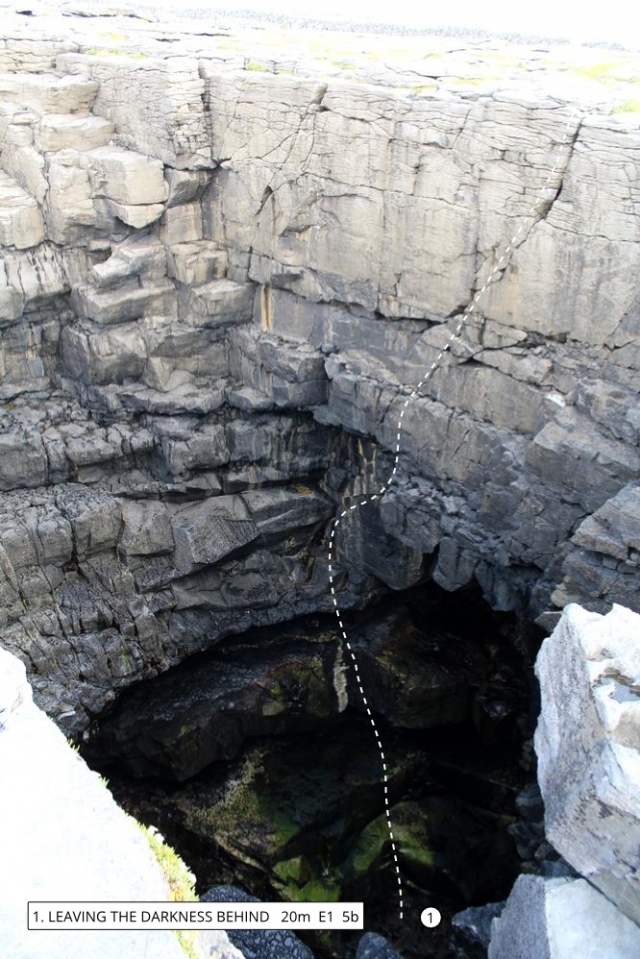
LEAVING THE DARKNESS BEHIND 20m E1 5b
Climb the NE corner/ledges and from the middle of the height move left on the East wall and climb the roof and diagonal crack to the top. Usually the bottom part is very damp so it could be climbed just from the corner in the middle of height.
An Colbha Garbh
There has been some development on a small cliff at the south-east end of the island (An Colbha Garbh). Follow the road which runs towards Gregory's Sound and from its end continue straight on through the fields to the coast. Walk to the last big boulder on the wave-cut platform (approx. 500m). Roughly 50m before the end of this platform there is a large protruding area of the cliff. The five routes are to the right of this.
These climbs were described in the 1997 guide as being at Aill na nGlasóg in the south-east corner of the island but are really further north at An Colba Garbh on the east coast
WILD EAST' HVS 5a 12m
Start in a shallow corner under the roof, about 3 m to the right from prominent undercut arête. Climb up for 3 m and start going leftward to climb on the roof at the arête. Finish straight up the arête.
EAST ROOF HVS 5a 10m
Start as WILD WEST. Start in a shallow corner under the roof, about 3 m to the right from prominent undercut arête. Climb straight up.
ARAN MAN 10m HS 4b
T. Fritzsche, 22/9/94.
3m right of the corner and roof. From the wedged block climb the cracks and ledges to the top.
BABY WET ONE 10m VD 3c
J. Hawkins (solo), 22/9/94.
2m right of Aran Man above a rock pool. Climb on good ledges to the top.
DODDLE 8m HS 4b
J. Hawkins, T. Frtizsche, 22/9/94.
4m right of Aran Man, to the right of the rock pool. Make a move up left and finish straight up past fossils.
HANGING SHORTLY 7m E1 5b
J. Hawkins, 22/9/94.
3m further right. Move up on a large wedged block to make a long move left, gain the ledge (crux) and finish straight up.
KURZ UND KRAFTIG 9m HVS 5a
J. Hawkins, T. Fritzsche, 22/9/94.
2m further right under the left hand end of the large roof. Climb under the overhang, surmount this using the crack and ledges. Finish straight up.
Inis Meain
Information has been supplied by Eoin Francis.
Routes on Inis Meain are generally not as long as Inis Mor but the routes area clean, steep, have great situations and use a variety of climbing styles being shorter and snappier than the longer sustained routes of Inis Mor.
Some new routes have been added recently. Most of these have filled in some of the more difficult remaining obvious lines. Some of the steeper and more exposed lines remain. There are some nesting birds at the end of the summer so you probably shouldn’t climb then.
Access:
Get a ferry to Inis Meain from Aran island ferries either from Galway or Rosaveil. You can also get a connection bus from Galway city to Rosamhíl. Expect to pay about 15Euros return. Getting here can take a long time so if you want to climb its worth checking the weather and expect it to rain at some stage. Camp near Synges Chair or stay in the hotel. If you don’t want to lug bags up to Synges Chair (about an hour) you can get a taxi or bring a bike.
Where are all the routes?
Starting from Synges chair head down below and about 100m left (look to the harbour you came from now look to your left to the sea cliffs. This area is where most of the steep abseil-in routes begin.
If you continue to the left you will come across various corners with obvious crack lines. Most of these have now been climbed. Some of the steep walls between them remain.
Another 50 m or so along ( walking away from the harbour you came from) on top of the sea cliffs you will come to a large open top area in the middle of which there is a blue descent rope used by fishermen. This gives easy access to the rest of the routes. These routes are tidal in bad weather but can usually be accessed from the wave cut platform below. There are numerous lines to the right and to the left of the fishermen's descent which have been done over the past 3 years.
